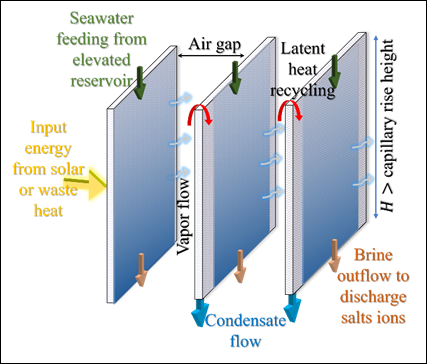In a boost to global water security, researchers at the Indian Institute of Science (IISc) have developed a siphon-powered thermal desalination system that converts seawater into clean drinking water faster, cheaper, and more efficiently than conventional methods.
Traditional solar stills, which replicate the natural water cycle, often face two challenges — salt buildup on evaporator surfaces and scaling limits that restrict water flow to just 10–15 cm. The IISc team has overcome both issues by harnessing the principle of siphonage.
The new system uses a composite siphon made of a fabric wick and a grooved metal surface. The fabric draws salty water from a reservoir while gravity ensures a continuous flow, flushing away salt before it can crystallize. The water then spreads as a thin film over a heated metal surface, evaporates, and condenses on a cooler surface placed just two millimeters away.
This ultra-narrow air-gap design significantly boosts efficiency, producing over six liters of potable water per square meter per hour under sunlight — several times higher than standard solar stills. The team has further enhanced productivity by stacking multiple evaporator–condenser pairs, allowing the device to recycle heat repeatedly.
Built using low-cost materials like aluminum and fabric, the system can run entirely on solar power or waste heat, making it ideal for off-grid villages, disaster-hit areas, and coastal regions. Remarkably, it can handle water with salt concentrations up to 20% without clogging, making it effective for brine treatment as well.
Published in the journal Desalination and supported by the Department of Science and Technology (DST), this innovation could be a game-changer for millions in water-stressed regions worldwide.
“This is about scalability, salt resistance, and simplicity — three things that have eluded solar desalination so far,” the researchers said, calling it a promising step toward making oceans a reliable source of safe drinking water.














